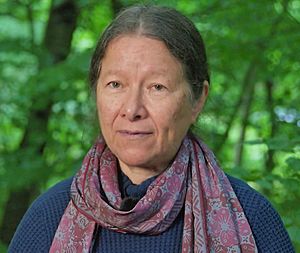Anna Tsing facts for kids
Anna Lowenhaupt Tsing (born in 1952) is a Chinese-American anthropologist. An anthropologist is a scientist who studies human societies and cultures. She is a professor at the University of California, Santa Cruz. In 2018, she received a special award called the Huxley Memorial Medal from the Royal Anthropological Institute.
Contents
Anna Tsing's Journey in Education
Anna Tsing studied at some great universities. She earned her first degree, a B.A., from Yale University. Later, she completed her M.A. (Master of Arts) in 1976 and her PhD (Doctor of Philosophy) in 1984 at Stanford University. A PhD is the highest degree you can get in many fields.
Anna Tsing's Career and Research
After finishing her PhD, Anna Tsing started teaching. She was a visiting assistant professor at the University of Colorado Boulder from 1984 to 1986. Then, she became an assistant professor at the University of Massachusetts Amherst from 1986 to 1989. After that, she joined UC Santa Cruz, where she still teaches today.
Professor Tsing has written many articles for important journals. She won the Harry Benda Prize for her book In the Realm of the Diamond Queen in 1994. Her second book, Friction: An Ethnography of Global Connection (2005), also won a major award called the Senior Book Prize.
In 2010, she received a Guggenheim Fellowship. This is a special award that helps scholars do important research. Her project was about the matsutake mushroom and how different species live together.
In 2013, Tsing was given the Niels Bohr Professorship in Denmark. This award recognized her work that connects different subjects like humanities, science, and art. She also helped create a program to study the Anthropocene. This is a term for the current time period where human activities greatly affect the Earth. She directed a research center called AURA (Aarhus University Research on the Anthropocene).
Anna Tsing has also been part of important groups like the American Anthropological Association. From 1999 until his death in 2024, she was in a relationship with James C. Scott, who was also a political scientist and anthropologist.
Big Ideas and Themes in Her Work
Understanding the Plantationocene
Anna Tsing, along with another scholar named Donna Haraway, came up with a term called "Plantationocene." This is an alternative idea to the "Anthropocene." The Anthropocene suggests that all human activities are equally changing our planet. However, Tsing and Haraway point out that not all people have caused the same amount of environmental problems.
They suggest that the "Plantationocene" began when colonialism started in the Americas around the 1500s. They highlight the difficult history of plantations. Spanish and Portuguese colonists brought plantation models to the Americas. These plantations used slavery (forced labor), used land very intensely, and were part of global trade. They also involved constant racialized violence. All these things changed the lives of people and nature around the world.
Plantations, both in the past and present, have played a big role in the history of colonialism, capitalism, and racism. These histories are connected to today's environmental issues. They show how some people became more vulnerable to things like warming temperatures, rising sea levels, pollution, and losing their land.
Important Books by Anna Tsing
Here are some of Anna Tsing's well-known books:
- In the Realm of the Diamond Queen: Marginality in an Out-of-the-way Place (1993)
This book is about people from the Meratus Dayak group in South Kalimantan, Indonesia. Anna Tsing learned a lot from a woman named Uma Adang. Uma Adang shared insights into shamanism (a spiritual practice), politics, and stories related to their ethnic identity. The book looks at how some groups are treated as "outsiders" within a country and how communities work, especially considering gender roles.
- Friction: An Ethnography of Global Connection (2004)
In this book, Anna Tsing studies the Meratus Mountains in Indonesia. She uses the word "friction" to describe how global connections are often "awkward, unequal, unstable, and creative." It's like when two things rub together – it's not always smooth. This book explores how companies use natural resources, how globalization works, and how people fight for the environment.
Tsing suggests that "friction" is a better way to understand global connections than just thinking everything is smoothly developing into one "global society." She argues that this idea of smooth development often comes from a powerful, Western point of view. She shows how environmental destruction in Indonesia, for example, didn't benefit local people but instead created goods for foreign powers. This led to people from different parts of Indonesia working together to protest.
By using "friction," Tsing shows that globalization isn't a simple, unstoppable force. It's a "messy" process that affects different places and people in many different ways.
- The Mushroom at the End of the World: On the Possibility of Life in Capitalist Ruins (2015)
This book is about the matsutake mushroom, which is rare and highly valued in Japan. These mushrooms grow in places that have been changed by humans, often with certain pine trees. Tsing uses the matsutake mushroom to study how different species interact. By looking at this non-human subject, she learns more about the human world.
Tsing follows the mushroom's journey around the world. This helps her explore bigger ideas about how human actions shape nature and what it means to be human in connection with other species. This book won two awards: the Gregory Bateson Prize and the Victor Turner Prize.
- Arts of Living on a Damaged Planet: Ghosts and Monsters of the Anthropocene (2017)


